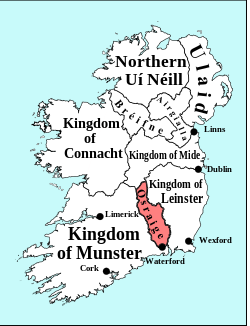Ossory Osraige | |||||||||||
|---|---|---|---|---|---|---|---|---|---|---|---|
| 150[1]–1541 | |||||||||||
 A map of Ireland showing Osraige in the 10th century. | |||||||||||
| Capital | Kilkenny | ||||||||||
| Common languages | Old Irish, Middle Irish, Latin | ||||||||||
| Religion | Celtic polytheism (pre-432), Celtic Christianity (c. 432–1152), Roman Catholicism (c. 1152–1541) | ||||||||||
| Government | Monarchy | ||||||||||
| First and last Kings | |||||||||||
• (eponymous founder) c. 150 AD | Óengus Osrithe | ||||||||||
• (last king of major Osraige) d. 1194 | Maelseachlainn Mac Gilla Pátraic [2] | ||||||||||
• submitted 1537; ennobled 1541 | Brian Mac Giolla Phádraig | ||||||||||
| History | |||||||||||
• Osraige | 150[1] | ||||||||||
• Disestablished | 1541 | ||||||||||
| |||||||||||
| Today part of | Republic of Ireland | ||||||||||
Osraige (Old Irish)[3] or Osraighe (Classical Irish), Osraí (Modern Irish), anglicized as Ossory, was a medieval Irish kingdom comprising what is now County Kilkenny and western County Laois, corresponding to the Diocese of Ossory. The home of the Osraige people, it existed from around the first century until the Norman invasion of Ireland in the 12th century. It was ruled by the Dál Birn dynasty, whose medieval descendants assumed the surname Mac Giolla Phádraig.
According to tradition, Osraige was founded by Óengus Osrithe in the 1st century and was originally within the province of Leinster. In the 5th century, the Corcu Loígde of Munster displaced the Dál Birn and brought Osraige under Munster's direct control. The Dál Birn returned to power in the 7th century, though Osraige remained nominally part of Munster until 859, when it achieved formal independence under the powerful king Cerball mac Dúnlainge. Osraige's rulers remained major players in Irish politics for the next three centuries, though they never vied for the High Kingship. In the early 12th century, dynastic infighting fragmented the kingdom, and it was re-adjoined to Leinster. The Normans under Strongbow invaded Ireland beginning in 1169, and most of Osraige collapsed under pressure from Norman leader William Marshal. The northern part of the kingdom, eventually known as Upper Ossory, survived intact under the hereditary lordship until the reign of King Henry VIII of England, when it was formally incorporated as a barony of the same name.
- ^ Genealogies from Bodleian Library, MS Rawlinson B 502 and the Book of Leinster
- ^ Annals of Loch Cé 1193.13, Four Masters 1194.6
- ^ "Osraige pronunciation: How to pronounce Osraige in Irish". Forvo.com. 19 November 2014. Retrieved 16 March 2017.